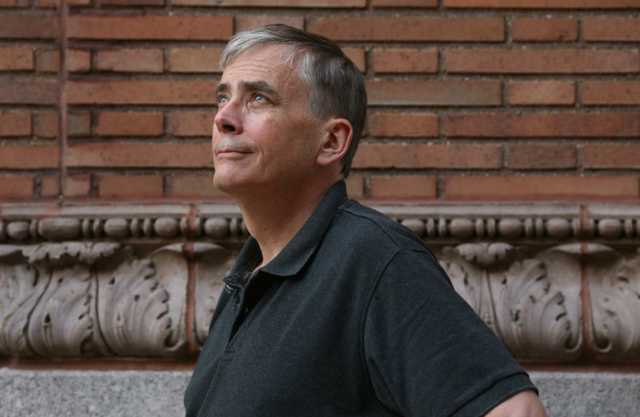
Christopher Gray smiles near acanthus-bedecked building in New York. (NYT)
Just got a sad email from Irving Sheldon, my friend and former colleague at the Providence Journal, that Christopher Gray has just died. From 1987 to 2014, he wrote the weekly “Streetscapes” column in the real-estate section on Sundays for the New York Times.
Gray’s column was not strictly architecture criticism, for he wrote not to praise or damn particular buildings or styles, as I do. No, he wrote lovingly detailed the histories of buildings, great and small, mostly in Manhattan, and part of his genius was to wrap into those histories the endearing (or vexing) tales of their owners, occupants, architects, builders and other associated human beings. In short, he brought architecture to life. Gray also ran a business, the Office for Metropolitan History, which he founded in 1975 to help clients research the history of buildings in which they were interested, and whose existence his widow apparently intends to perpetuate.
Shel knew Gray from school, and introduced me to his writing long ago. His work did not convey stylistic preferences other than passively, at least most of the time. Through the buildings he chose to write about you could get a feel for his preferences. Or maybe I am just “projecting” my own preferences into the mind of someone I admired so much.
Here is David Dunlap’s obituary of Gray in the Times: “Christopher Gray, Architecture Writer and Researcher, Dies at 66.” Here is his last column, “Down the Block, Deep in the Stacks,” on Dec. 26, 2014.
Gray retired from the New York Times at about the same time I was released from the Journal after its sale. I wrote Gray and then called him. I was throwing hail-Mary job applications, and had tossed one of these to the Times, but Gray told me with considerable regret that the paper was not hiring but laying off scores and scores of writers and editors, and that my chances there were nil. Of course, I already knew they were nil because my take on architecture was non grata at the Times. Sure, Gray himself seemed to be evidence to the contrary. Maybe this was why I thought maybe I had a sliver of a chance to latch on somehow.
So I may personally thank Christopher Gray for allowing me to build happy (if temporary) castles in the dreamy sandbox of my own mind. He has ennobled his world. May he rest in peace.




Thank you, David for this piece on Christopher Gray, whom I had never before heard of, and especially for the links to his obit and last column. Jane Jacobs and other great urbanists have written of the city as itself a living organism. Christopher Alexander wrote of buildings as being alive (or not). Just this brief introduction to Gray causes me to think of him as a biographer of buildings that make up what some describe as “the fine grain” of our urban environments. There are within cities certain buildings, and as Gray chronicled, not just the prominent “iconic” ones, that have lives and stories which contribute so much to making cities what (who?) they uniquely are. I plan on reading that published collection of his columns.
LikeLike